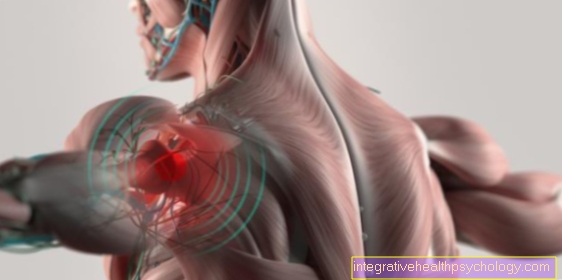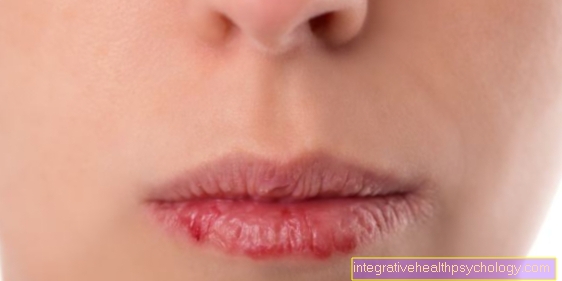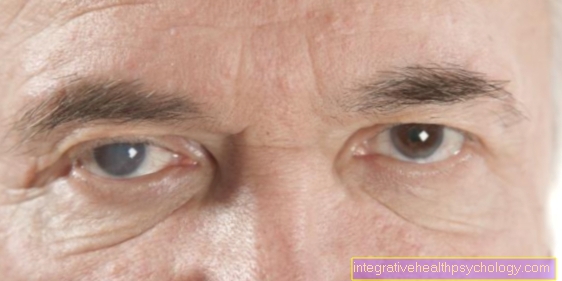Ursodeoxcholic acid
introduction
Ursodeoxycholic acid is a preparation used to treat small gallstones containing cholesterol (Cholelithiasis). In Germany around 15 to 20% of people suffer from gallstone disease. Women are more often affected than men.
In addition to the female gender, typical risk factors include obesity (Obesity), old age (older than 40 years) and the presence of gallstones in first-degree relatives. In 80% of the cases, the gallstones are cholesterol-containing stones.
Symptoms only occur in around 25% of patients with gallstones. This typically results in pain on the right side of the upper abdomen, which can also radiate into the shoulders or back.
Read more on the topic: Gallstones

Indications for ursodeoxycholic acid
Ursodeoxycholic acid is used to treat gallstones (Cholelithiasis), which are made up of cholesterol. Other important prerequisites for the application are the size (<15mm), a functional gallbladder and other findings from ultrasound diagnostics (e.g. no visible shading in the area of the gallstone).
Ursodeoxycholic acid can also be used in the treatment of cirrhosis of the liver. The aim is to prevent the progression of cirrhosis of the liver, which is caused by chronic inflammation of the biliary tract or a backlog of the bile (e.g. during a primary biliary cirrhosis) was created.
In rare cases, ursodeoxycholic acid is also prescribed to treat inflammation of the lining of the stomach, caused by bile flowing back into the stomach from the small intestine (Biliary reflux gastritis).
You might also be interested in: Gallstone disease
How does ursodeoxycholic acid work?
Gallstones are caused by an imbalance between the various substances in the bile. In addition to the bile acids, there are also dissolved substances (e.g. cholesterol) in the bile. Due to a high proportion of cholesterol with a simultaneously low concentration of bile acids, stones containing cholesterol precipitate within the bile ducts.
Ursodeoxycholic acid, which occurs naturally in very low concentrations in the bile, counteracts the formation of gallstones in various ways and also leads to the dissolution of small stones containing cholesterol. On the one hand, ursodeoxycholic acid inhibits the absorption of cholesterol from the intestine into the human body, while at the same time the release of cholesterol from the liver cells into the bile is reduced. On the other hand, ursodeoxycholic acid stimulates the release of bile acids from the liver cells into the bile fluid. The lower cholesterol and higher bile acid concentrations prevent the formation of cholesterol-containing gallstones and at the same time, small, existing stones can be dissolved.
In addition, ursodeoxycholic acid also has a cell-protecting effect by inhibiting chronic inflammatory reactions. This can protect liver cells damaged by chronic inflammation and delay the progression of cirrhosis.
You might also be interested in the topic : Gallbladder
Side effects
Serious side effects occur only in very rare cases during therapy with ursodeoxycholic acid.
However, diarrhea is common (1 to 10 patients in 100). This is due, among other things, to the inhibited absorption of cholesterol from the intestines into the body, which causes high amounts of cholesterol to be excreted. The stool is often described as mushy by the affected patients.
In very rare cases (less than 1 in 10,000 patients) calcification of the gallstones or hives can occur as part of the therapy. Patients with known cirrhosis of the liver (due to a build-up of bile) can also experience severe pain in the right upper abdomen.Worsening of the liver cirrhosis is possible in very rare cases and it is necessary to discontinue therapy.
Interactions
The effectiveness of ursodeoxycholic acid can be impaired during treatment with drugs that bind with bile acids. The bile acid binding preparations include, among other things Cholestyramine. This has the property of binding and excreting the bile acids in the intestine. As a result, new bile acids have to be formed from cholesterol in the liver, which can lower human cholesterol levels. At the same time, however, ursodeoxycholic acid is no longer absorbed in the intestine and can therefore no longer cause the gallstones to dissolve within the biliary tract. For this reason, a delayed intake (at least 2 hours) is recommended.
Further interactions can occur through the metabolism of ursodeoxycholic acid via specific liver enzymes (e.g. CYP3A4), through which numerous other preparations are also metabolized. Studies have already reported an increased effect of ciclospoprin A and a weakened effect of ciprofloxacin or nitrendipine.
Read more on the topic: cholesterol
Contraindications
You should refrain from taking ursodeoxycholic acid if you are known to be hypersensitive to the ingredient.
In addition, the administration of ursodeoxycholic acid is not indicated for acute inflammation of the gallbladder or biliary tract. Even with acute or chronic liver inflammation (Hepatitis) ursodeoxycholic acid should not be taken. Ursodeoxycholic acid is not effective even on stones that do not contain cholesterol. These can arise, for example, from an increased proportion of calcium carbonate or bilirubin in the biliary tract.
You might also be interested in: Inflammation of the gallbladder
dosage
The preparation ursodeoxycholic acid is indicated for the treatment of cholesterol-containing gallstones in adults. However, in rare cases, it can also be prescribed to children aged 6 and over. However, the dosage must be adjusted to the body weight of the child.
A daily dose of approximately 10 mg per kilogram of body weight is recommended to dissolve cholesterol gallstones. If you weigh between 60 and 80 kilograms, you should take 250mg tablets three times a day. For the treatment of cirrhosis of the liver due to biliary backlog, the dosage is also adjusted to the body weight. The exact therapy plan must be discussed with the attending physician and comprises between 4 and 5 film-coated tablets a day.
During treatment with ursodeoxycholic acid, the liver enzyme levels in the blood and the gall bladder should be checked regularly using ultrasound. If there is no improvement in the symptoms or the clinical picture after one year, discontinuation of therapy should be considered.
Read more on the topic: Diagnosing gallstones
price
The preparations of ursodeoxycholic acid most frequently on the market in Germany are Ursofalk and UDH. Both (film) tablets and capsules are available. They are available from pharmacies with a prescription.
Usually ursodeoxycholic acid is offered in both a 250mg and a 500mg dosage. Different pack sizes (50 and 100 tablets per pack) are also available.
A 50-pack with 250mg ursodeoxycholic acid is available for approximately 25 euros. A pack of 100 costs around 40 euros instead.
Ursodeoxycholic acid and alcohol - are they compatible?
No direct interaction is known between ursodeoxycholic acid and alcohol. In addition, alcohol only has a minor influence on the formation of gallstones. Above all, obesity and a high-fat diet are a risk factor for the development.
Nevertheless, there can be interactions between alcohol and ursodeoxycholic acid within the liver, since both substances are metabolized in the liver. At the same time, high alcohol consumption is a risk factor for the development of liver cirrhosis, which counteracts therapy with ursodeoxycholic acid in the context of liver cirrhosis through biliary reflux. For this reason, alcohol consumption should be minimized or interrupted during treatment with ursodeoxycholic acid.
Alternatives to ursodeoxycholic acid
Treatment with ursodeoxycholic acid often has only a limited effect on the formation and dissolution of gallstones. Chenodeoxycholic acid, which has a comparable effect, did not respond better either. For this reason, symptomatic drug treatment is often required.
The very painful upper abdominal pain can be treated with antispasmodics (e.g. Metamizole, tramadol, butylscopolamine) be treated. If necessary, herbal products can also be used (e.g. artichoke leaves, yarrow, dandelion).
However, surgical removal is usually required for symptomatic gallstones.
You might also be interested in: Treatment of gallbladder inflammation
Can it be taken during pregnancy and breastfeeding?
Therapy with ursodeoxycholic acid should be avoided during pregnancy and breastfeeding. There are insufficient investigations and studies that can rule out an effect of the preparation on the baby. There is a risk that the active substance could enter the baby's body via the placenta or breast milk.
In addition, pregnancy should also be ruled out before starting therapy with ursodeoxycholic acid.
Ursodeoxycholic acid and the pill - is it compatible?
Non-hormonal contraceptive measures or low-dose, estrogen-based contraceptives are recommended during treatment with ursodeoxycholic acid.
If ursodeoxycholic acid is prescribed to treat gallstones, only non-hormonal contraceptives should be used. This is because the hormonal contraceptives (pill) can promote the formation of gallstones and thus counteract the effects of ursodeoxycholic acid.
Is there a prescription-free ursodeoxycholic acid?
Ursodeoxycholic acid is only available with a prescription in pharmacies. The intake, dosage and application should always be carried out in close consultation with the attending physician. Herbal products can be taken as a support. Artichoke leaves optimize the composition of the bile, while yarrow and dandelion have a cholagogue effect.
You might also be interested in: Homeopathy for gallstones






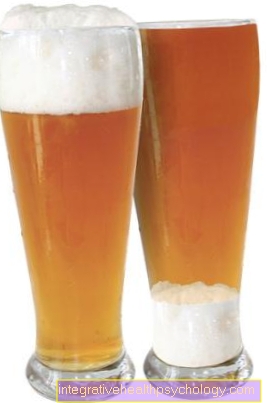





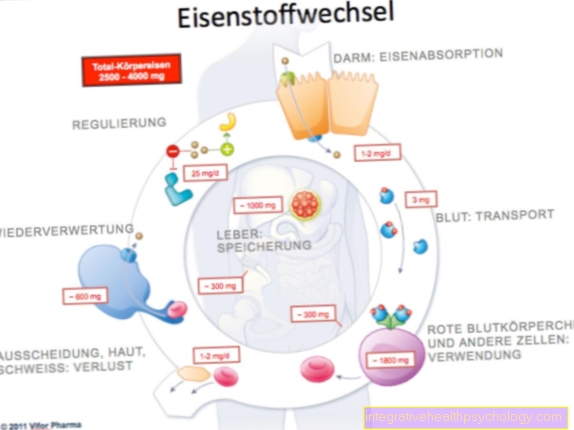
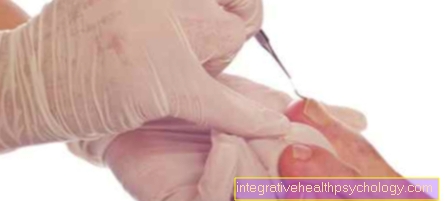

.jpg)


